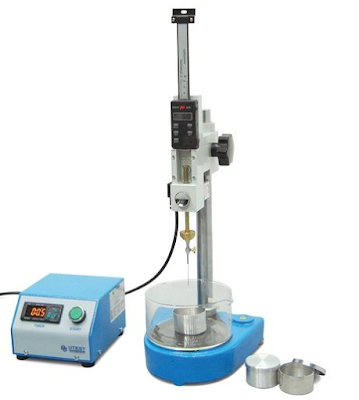Standard Test Method (ASTM D5) for Penetration of Bituminous Materials lab report
EXPERIMENT NAME: Standard Test
Method (ASTM D5) for Penetration of Bituminous Materials.
Purpose of the Test
Consistency of a bituminous material expressed as the distance
in tenths of a millimeter that a standard needle vertically penetrates a sample
of the material under known conditions of loading, time, and temperature.
1.
The penetration test is using as a measure of the consistency.
Greater values of penetration determine softer steady.
2.
The test is widely used all over the world for classifying bituminous
materials into different grades.
3.
Rely on upon the weather condition and types of construction,
bitumen of various penetration grade are using. Generally using grade are
30/40, 60/70 and 80/100.
4.
In warmer regions, lower penetration grades are preferred and in
colder regions bitumen with higher penetration values are used.
5.
The test is not intended to estimate steady of softer materials
like cut back which are usually graded by vise intentional ossify test.
GRADES OF BITUMEN:
Bitumen is usually characterized in the following three types of
grades;
1.
Viscosity grades
2.
Penetration grades
3. Density
grades
APPARATUS
·
Penetration test Apparatus
·
Penetration Needle
·
Sample Container — A metal or glass cylindrical,
flat-bottom container of the following dimensions shall be used.
·
Water Bath — A bath having a capacity of at least 10 Liter and capable of
maintaining a temperature of 25 ±
0.1 °C or other temperature of test within 0.1 °C.
·
Timing Device hand operated penetrometers any convenient Stop watch required.
·
Thermometers temperature 0° to 50°C with subdivisions maximum scale
error 0.1°
,
PREPARATION OF TEST SPECIMEN
Heat the sample wcarefully, stirring when it possible to withstand
local over heating, until it has become enough fluid to effuse. In no other
case should be the temperature be increased to more than 90 °C up expected soft
point for petroleum asphalt. Do not heat specimen for more than thirty minutes.
Avoid incorporating bubble into the specimen.
Effuse the specimen into the specimen jar to
the depth such that, when cooling to the temperature of test, the depth of the
specimen is at least 10 mm higher than
the depth to which the needles expected
to penetrate. Effuse 2 separate portions for each difference in test situation .
Loosely cover each container as a protection against dust
(covering with a lipped beaker) and allow cooling in air at a temperature
between 15° and 30 °C
for 1 to 1.5 hours for
the small container and 1.5 to 2 hours
for the taller.
TEST CONDITIONS
Where the situation of this
test are not specific mentioned, to the temperature, load, and time are
understand to be 25 °C, 100 gm,
and five seconds, respectively. Other situation are may be using for
special test, such as the following:
in such cases the specific situation of test will be reported.
REPORT
Report to the closely
full unit the average of 3 penetration whose values didn`t various more
than the following table :
PROCEDURE
Ø Examine the needle holder and
guide to establish the absence of water and other extraneous materials. Clean a
penetration needle with toluene or
other suitable solvent, dry with a clean cloth, and insert the
needle into the penetrometer. if not, otherwise specific place to the fifty(50) gm weight above the needle,
making the total weight 100 ± 0.1 gm.
Place the sample jar in the transfer
dish, cover the container fully with water the constant temperature bath and the place in
to transfer dish on the stand to the penetrometer.
Ø
Position the needle by slowly lowering it until its tip just
makes contact with the surface of the sample. This is accomplished by the
taking of actual needle tip into the contact with its image reflected on the
surface of the specimen from properly
placed source of the light. Either annotation the reading of the penetrometer
dial the pointer to 0(zero). Quickly leave the needle holder for the specific
period of the time and adjust apparatus to
measure the distance penetrated in tenths of a millimeter. If the vas is moving, omit the result.
Ø Make at least three
determinations at points on the surface of the sample not less than 10 mm from the side of the
container and not less than 10 mm apart. If the transfer dish is used, return
the sample and transfer dish to the constant temperature bath between
determinations. Use a clean needle for each determination. If the penetration
is greater than 200, using at least 3 needle for leaving them into specimen
until the3 determination completed.
If the differences are exceeded repeat the test using second sample.
If the appropriate tolerance is again exceeded ignore all result
and repeat the test completely.









Nice Post!!
ReplyDeletePlease look here at Bitumen Emulsion